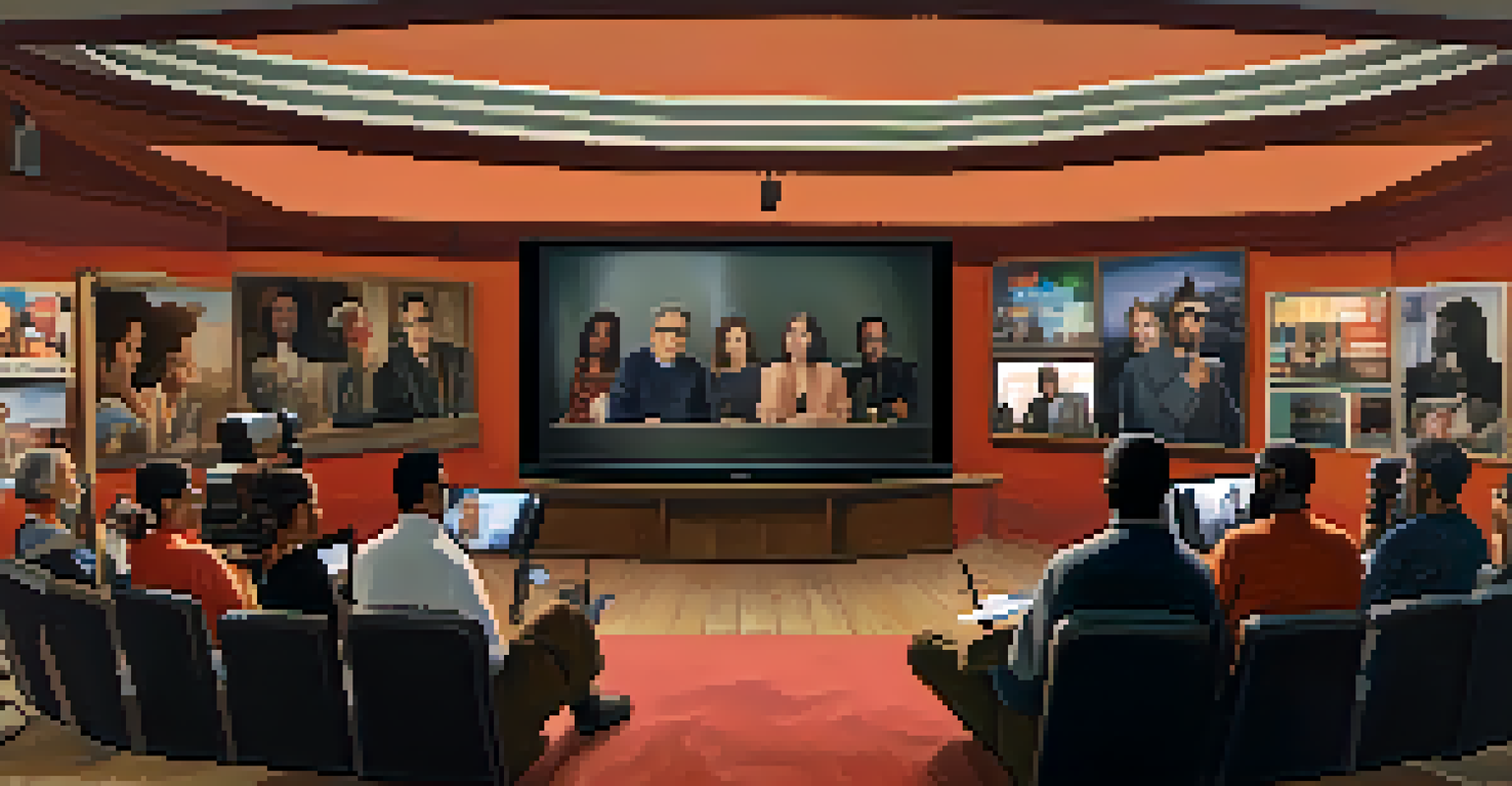Online Platforms and Their Influence on Film Criticism Today

The Rise of Online Platforms in Film Criticism
In recent years, online platforms have revolutionized film criticism. Traditional print media has seen a decline, giving way to blogs, social media, and video reviews. This shift allows anyone with internet access to share their opinions, democratizing film critique like never before.
The internet has democratized film criticism, giving everyone a voice and allowing for diverse perspectives.
Websites like Rotten Tomatoes and IMDb have become go-to sources for movie ratings and reviews. These platforms aggregate user reviews alongside professional critiques, creating a more comprehensive view of a film's reception. It’s not just critics who have a voice anymore; everyday viewers can influence a film's success through their ratings.
This accessibility has also led to an explosion of diverse voices in film criticism. Independent critics and niche reviewers can share unique perspectives that may be overlooked by mainstream outlets. As a result, audiences are exposed to a broader range of insights and opinions.
Social Media's Role in Film Criticism
Social media platforms like Twitter, Instagram, and TikTok have transformed how film criticism is shared and consumed. Critics and fans alike engage in conversations around films in real-time, creating a dynamic dialogue that wasn't possible before. This instant feedback loop can significantly influence public perception and box office performance.

For example, a tweet from a popular critic can quickly go viral, impacting a film's buzz. Hashtags related to a film can trend, drawing in viewers who are curious about the latest cinematic release. This immediacy fosters a sense of community among film lovers, encouraging discussions that extend beyond the theater.
Online Platforms Democratize Critique
The shift to online platforms has allowed everyday viewers to share their opinions, diversifying the voices in film criticism.
However, this rapid exchange can also lead to misinformation or hasty judgments. With so many opinions flying around, distinguishing between thoughtful critiques and fleeting trends becomes crucial. Viewers must navigate this landscape carefully, weighing opinions from various sources.
The Impact of User-Generated Content
User-generated content (UGC) is at the heart of many online platforms, reshaping how films are critiqued. Platforms like YouTube and TikTok allow users to create video reviews, unboxings, and commentary that can reach vast audiences. These videos often highlight personal experiences, making critiques relatable and engaging.
In the age of social media, a tweet can shape a film's reputation overnight.
This shift towards UGC means that film criticism is no longer limited to professionals. Amateur critics often bring fresh perspectives and unique takes that resonate with everyday viewers. Their authenticity can forge a deeper connection with audiences, who may feel more represented than in traditional critiques.
As a result, traditional critics now face competition from these grassroots critics. This dynamic is pushing established critics to adapt their styles and embrace more interactive formats, blending traditional analysis with the informal touch of social media.
The Challenge of Credibility in Film Criticism
With the rise of online platforms, the question of credibility in film criticism has come to the forefront. Anyone can publish a review, leading to a mix of high-quality insights and less informed opinions. As a result, audiences may struggle to discern which reviews to trust.
Critics often establish their credibility through experience and expertise, but how does that translate online? Many viewers now look for credentials, follower counts, or engagement metrics to gauge a critic's reliability. This reliance on popularity can sometimes overshadow the substance of the critique itself.
Social Media Shapes Film Discussions
Social media fosters real-time conversations about films, creating a dynamic environment that can influence public perception and box office success.
Navigating this landscape means that both critics and audiences must be discerning. Viewers should seek out diverse voices while also considering the background and qualifications of the critics they follow. This balance can help ensure that the discourse around films remains informed and enriching.
The Evolution of Critique Formats
The format of film criticism has evolved alongside technology, moving from written reviews to a variety of multimedia formats. Podcasts, video essays, and livestream discussions offer new ways to engage with film analysis. These formats allow for deeper dives into thematic elements and storytelling techniques.
For instance, a podcast episode can explore a film's cultural context in a conversational format, making complex ideas more accessible. Video essays can use clips and visuals to illustrate points, creating a more immersive experience for the viewer. This variety caters to different learning styles and preferences, broadening the audience for film critique.
As critics experiment with these new formats, they also challenge traditional notions of what a film review should look like. This evolution may encourage more people to engage with film criticism, fostering a culture where analysis and discussion are valued.
The Influence of Algorithms on Film Exposure
Algorithms play a crucial role in determining which films are seen and discussed online. Platforms like Netflix and YouTube use algorithms to recommend content, often prioritizing popular films or trending topics. This can shape public perception and interest, sometimes overshadowing lesser-known but equally deserving films.
As a result, films that align with trending topics or popular genres may receive disproportionate attention. This phenomenon can lead to a cycle where certain films dominate discussions, while others go unnoticed. Critics and audiences alike must be aware of these biases to ensure a diverse range of films is considered.
Credibility Challenges in Criticism
With many voices in film criticism, audiences must discern credible critiques from less informed opinions to ensure informed discussions.
Critics can counteract this trend by actively seeking out and promoting underrepresented films. By highlighting hidden gems, they can help broaden the conversation and encourage audiences to explore beyond mainstream offerings.
Future Trends in Film Criticism Online
As technology continues to evolve, so too will film criticism. The rise of artificial intelligence and machine learning may influence how films are critiqued and discussed online. For instance, AI could assist in analyzing viewer preferences or even generating reviews, raising questions about authenticity.
Additionally, virtual reality (VR) and augmented reality (AR) technologies may create immersive critique experiences. Imagine stepping into a virtual theater where critics share their insights while you experience scenes from the film firsthand. This could revolutionize how audiences engage with film analysis.

While these advancements hold exciting potential, they also come with challenges. Critics and audiences must navigate the balance between innovation and the essence of thoughtful critique. As we look to the future, maintaining a focus on genuine engagement and diverse perspectives will be key.